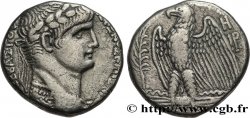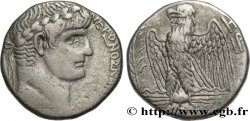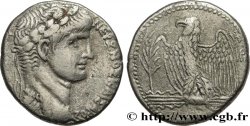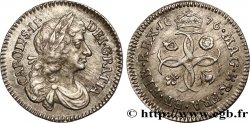E-auction 107-56859 - bpv_297332 - NERO Tétradrachme syro-phénicien
You must signin and be an approved bidder to bid, LOGIN TO BID. Accounts are subject to approval and the approval process takes place within 48 hours. Do not wait until the day a sale closes to register. Clicking on « bid » constitutes acceptance of the terms of use of cgb.fr private e-auctions.
Bids must be placed in whole Euro amounts only. The sale will start closing at the time stated on the item description; any bids received at the site after the closing time will not be executed. Transmission times may vary and bids could be rejected if you wait until the last second. For further information ckeck the E-auctions F.A.Q.
NO BUYER'S FEE.
NO BUYER'S FEE.
| Estimate : | 130 € |
| Price : | 72 € |
| Maximum bid : | 86 € |
| End of the sale : | 04 May 2015 15:59:30 |
| bidders : | 6 bidders |
Type : Tétradrachme syro-phénicien
Date: 67-68
Mint name / Town : Antioche, Syrie, Séleucie et Piérie
Metal : silver
Diameter : 24 mm
Orientation dies : 12 h.
Weight : 14,43 g.
Coments on the condition:
Bon portrait
Catalogue references :
Predigree :
Cet exemplaire est le 0092_039. Il provient de la vente CNG Triton XII, lot: 1275
Obverse
Obverse description : Buste lauré de Néron à droite avec l'égide sur le cou (O*4).
Obverse legend : NERWN KAISAR - SEBASTOS, (Nerwn Kaisar Sebastos)
Obverse translation : (Néron césar auguste).
Reverse
Reverse description : Aigle debout à gauche sur une deux branches de laurier opposées, les ailes déployées ; dans le champ à gauche, une palme verticale.
Reverse legend : ETOUS/ sIR
Reverse translation : (an 116 de l’ère césarienne).
Commentary
Le portrait de cet exemplaire est tardif, proche des deniers habituels de l’atelier de Rome, et est dans la continuité des exemplaires de l’an 112 sur le plan du style, toujours de grande qualité et typiquement hellénistique, loin des stéréotypes de l’atelier de Rome.
Curieusement, l’aigle n’est plus sur une massue, comme dans l’émission précédent (Prieur 91), ni sur un foudre, comme depuis le début des frappes à l’aigle, mais sur une couronne de laurier. Rappel d’une distinction reçue par la vile en cette année ? On remarque à ce propos que les aigles des frappes de ce millésime portent la couronne dans le bec, probablement une distinction accordée à la ville émettrice, contrairement aux aigles des premières frappes de Néron, sans couronne.
Les sigma sont traités en C. Dans la base TSP maintenue par Michel Prieur,cinquante deux exemplaires seulement sont maintenant répertoriés.
The portrait on this example is late, close to the usual denarii from the Roman mint, and is in line with the examples of the year 112 in terms of style, always of high quality and typically Hellenistic, far from the stereotypes of the Roman mint. Curiously, the eagle is no longer on a club, as in the previous issue (Prieur 91), nor on a thunderbolt, as since the beginning of eagle strikes, but on a laurel wreath. A reminder of a distinction received by the city in this year? We note in this regard that the eagles of the strikes of this vintage carry the crown in the beak, probably a distinction granted to the issuing city, unlike the eagles of the first strikes of Nero, without a crown. The sigmas are treated in C. In the TSP database maintained by Michel Prieur, only fifty-two examples are now listed
Curieusement, l’aigle n’est plus sur une massue, comme dans l’émission précédent (Prieur 91), ni sur un foudre, comme depuis le début des frappes à l’aigle, mais sur une couronne de laurier. Rappel d’une distinction reçue par la vile en cette année ? On remarque à ce propos que les aigles des frappes de ce millésime portent la couronne dans le bec, probablement une distinction accordée à la ville émettrice, contrairement aux aigles des premières frappes de Néron, sans couronne.
Les sigma sont traités en C. Dans la base TSP maintenue par Michel Prieur,cinquante deux exemplaires seulement sont maintenant répertoriés.
The portrait on this example is late, close to the usual denarii from the Roman mint, and is in line with the examples of the year 112 in terms of style, always of high quality and typically Hellenistic, far from the stereotypes of the Roman mint. Curiously, the eagle is no longer on a club, as in the previous issue (Prieur 91), nor on a thunderbolt, as since the beginning of eagle strikes, but on a laurel wreath. A reminder of a distinction received by the city in this year? We note in this regard that the eagles of the strikes of this vintage carry the crown in the beak, probably a distinction granted to the issuing city, unlike the eagles of the first strikes of Nero, without a crown. The sigmas are treated in C. In the TSP database maintained by Michel Prieur, only fifty-two examples are now listed








 Report a mistake
Report a mistake Print the page
Print the page Share my selection
Share my selection Ask a question
Ask a question Consign / sell
Consign / sell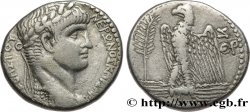
 Full data
Full data